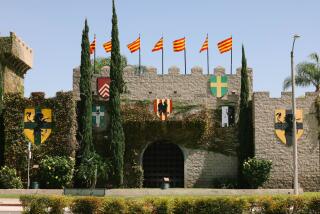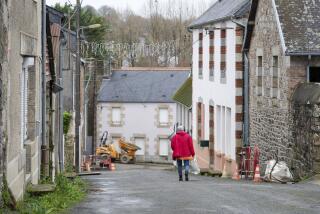Medieval France town is under siege — by tourists

SAINT-CIRQ LAPOPIE, France — The valley of the Lot River as it wends its way through southwestern France is known for its exceptional natural beauty, picturesque villages and historic chateaux.
Saint-Cirq Lapopie, however, stands out in every sense of the term.
Rising majestically from atop an almost sheer rock bluff, more than 300 feet above the river, the medieval settlement has a commanding view for miles in every direction.
It also stands out in the hearts of the French, who, despite a very wide choice of picture-postcard sites, voted Saint-Cirq Lapopie their favorite village in a nationwide television poll in May.
Having seen off marauding armies and rival fiefs for hundreds of years, Saint-Cirq Lapopie today faces an invasion of a different kind: tourists, drawn by a newfound celebrity that could prove as much of a double-edged sword as those wielded by ancient assailants.
This year the village of slightly more than 200 inhabitants expects about 600,000 visitors and has been forced to draw up a battle plan over how to welcome them, and the income they bring, without losing the ethereal charm that made it popular in the first place.
Mayor Gilles Hardeveld sees nothing but good in the modern-day assault on his village.
“You cannot please everyone, and there will always be those who complain about too many visitors, but we are very lucky to have this heritage. There are villages around us that have nothing, no visitors, even in summer,” he said. “Our challenge is to manage the tourists without losing our authenticity.”
Even with the benefit of 21st century transportation, Saint-Cirq Lapopie is not easy to reach. The narrow route winds through a bucolic landscape that has barely changed in centuries. Only the tourist buses weaving their way slowly up the road hacked out of the rock belie the era.
The stone buildings of Saint-Cirq Lapopie, 13 of them classified as historic, are built in a cluster on a grid of narrow cobbled streets, barely wide enough for a car and so steep that in places the sharply pointed roof of one cottage is at the same level as the garden fence of the neighboring property. The houses cling precariously to the rocky outcrop as if in danger of sliding down into the river below.
There is little evidence of the trimmings of modern life; no telephone cables, satellite dishes, electricity wires, most of which have been buried alongside the ancient foundations or hidden in roof spaces, under eaves or under the roads.
The village’s beauty has long made it a favorite with artistic visitors. After World War II, it became a haunt of French Surrealists when Andre Breton, the writer credited with founding the movement, bought a house there.
“Saint-Cirq Lapopie has cast a single enchantment over me. One that has fixed me forever. I no longer wish to be anywhere else,” Breton wrote.
Before the latest wave of tourists, Saint-Cirq Lapopie was famous not just for its fortifications but also its wood-turners. Once it had more than 100 of them producing wooden taps for wine and liquor barrels. Today, there is just Patrick Vinel, 56, who learned his trade from his father, who learned it from his father, and so on back five generations of Vinels.
Sitting at his workbench near an old belt-and-pedal lathe, Vinel describes himself as a “Saint-Cirquois de souche” (born and bred). He now turns out gifts for the tourists: miniature chess sets, wooden spinning tops, bowls.
“I’ve no reason to complain. Why would I? I make my living thanks to the tourists,” Vinel said.
On one of his shelves are photographs of the village in winter. The streets and the characteristic flat brown roof tiles of the houses are covered with several inches of snow.
Vinel says the tourists mostly come in July and August.
“In winter, I replenish my stock,” he said, waving an arm around the shop. “Where do you think this stuff comes from? It isn’t made in Taiwan, you know.”
On a scorching hot summer day, the village is packed with tourists, and the restaurants, shops and tourist office overrun. It is still possible to find a corner of tranquillity off the main streets where, away from the crowds, it is like stepping back in time.
Nobody wants to openly voice discontent with the tourist crowds, but there are a lot of anonymous huffing and puffing and oblique allusion to them. “There are people who say enough is enough,” said one local woman who did not want to be named.
Virginie Seguin, director of the tourist office, said it normally assists about 800 visitors a day in July and August. This year, after the poll, the number has doubled, sometimes tripled.
“It’s been pretty dense, but even with the tourists you can still have a calm walk and lose yourself in the old roads,” Seguin said.
“Of course, the locals are attached to their village and there are those who complain there are too many tourists. I respect this, but it’s the classic paradox. There are shops and services in the village thanks to the tourists. If there are no tourists, there is no boulangerie to buy bread or restaurants to eat in.
“We are surfing a wave of publicity and notoriety, but the notoriety will fade. It won’t be like this every year. The economic situation in France is difficult and we are very lucky.”
Mayor Hardeveld says he wants to encourage people to come not only during the summer but insists that the village won’t be compromised.
“Besides,” he said, “at the end of the day the tourists have gone and we all sleep very peacefully.”
Willsher is a special correspondent.
More to Read
Start your day right
Sign up for Essential California for news, features and recommendations from the L.A. Times and beyond in your inbox six days a week.
You may occasionally receive promotional content from the Los Angeles Times.






